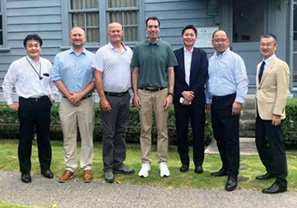U.S. wheat farmers, Japanese millers reaffirm relationship during reciprocal trade missions
Finalizing a wheat sale takes a click of a button, but maintaining a market as large and long-lasting as Japan requires decades of shared commitment between U.S. wheat farmers and Japanese customers. The success of these continued efforts was exemplified by this summer’s two trade missions, which both brought Japanese millers to the U.S. and took U.S. Wheat Associates’ (USW) new leadership to Japan on their first official trade visit.
“Our relationship with Japan is more than commercial, it is a deep-seated partnership built on decades of trust,” said USW President and CEO Mike Spier. “Through these reciprocal trade missions, we actively demonstrate our commitment to being a reliable supplier of high-quality wheat and continue to reaffirm the personal connections that are essential to doing business in this large and loyal market.”
From kitchens on wheels to trade titan
The relationship between U.S. wheat farmers and Japanese customers existed before USW’s start as an organization, dating back to a trade delegation organized by the Oregon Wheat Growers League (OWGL) in 1949, with the goal of exploring opportunities to expand U.S. wheat sales to Japan. In 1956, the OWGL opened an office in Tokyo to share information about wheat foods, prompting additional farmer organizations in the Pacific Northwest to join the effort and the establishment of the Western Wheat Associates. Over 30 years later, Western Wheat Associates merged with Great Plains Wheat to form U.S. Wheat Associates in 1980.
In USW’s early days, market activities focused on promoting the nutritional value of wheat foods. Along with introducing bread to Japanese school lunch programs, initiatives like “Kitchens on Wheels” traveled through rural Japan to promote wheat foods to Japanese customers.
Since then, Japan has cumulatively purchased more U.S. wheat than any other country. Today, the work has shifted from introducing wheat foods to meeting the needs of highly advanced Japanese milling and baking industries, including high standards of quality, cleanliness, and uniformity.
In the 2024-25 marketing year, Japan imported 2.13 million metric tons, nearly 78.3 million bushels, of U.S. wheat. These sales are slightly higher than the five-year average and represent an almost 12% increase from the prior year. As of Aug. 28, 2025, Japan has imported nearly 464,000 metric tons (17 million bushels) of U.S. wheat.

USW leadership renews connections with Japanese customers
In Japan, the team met with the top four flour milling companies. Together, these companies account for more than 80% of the country’s flour sales. Along with visiting many end-users, the USW leadership team also visited Japan’s largest baking company. In meetings with Japan’s Ministry of Agriculture, Forestry and Fisheries (MAFF), USW leadership expressed gratitude for nearly 70 years of successful cooperation.

“As expressed by one customer, Japanese business culture is built on the principle of harmony,” Brian Liedl, USW vice president of overseas operations, said. “To succeed in the Japanese market requires strong relationships, not just contracts. USW fits nicely into this model because we are the U.S. wheat farmer’s representation in the Japanese market. Building these relationships matters deeply when doing business with Japan.”
Jim Pellman, USW chairman and a wheat farmer from North Dakota, valued the ability to have honest conversations with Japanese buyers about the challenges of production agriculture. He talked with them, as he does with his children, about how wheat farmers need prices that sustain their business operations, just as Japanese end-users need to watch their own margins carefully.
“We export 50% of our wheat around the world, and we feed our own families with the other 50%,” Pellman said. “We all want good quality wheat and a reliable supply, and that’s what we are doing.”
Firsthand farm views create consistent demand
Traveling to Japan is only one half of the reciprocal efforts that sustain the U.S.-Japanese trade relationship. Throughout the year, trade teams of Japanese customers come to the U.S. for a firsthand look at the current U.S. wheat crop and to explore the U.S. grain breeding, production, handling, inspection, and export systems. In July, just weeks before the USW leadership team took off for Tokyo, a trade team of mid-level managers from the Japan Flour Millers Association (JFMA) traveled to Montana, Washington, and Oregon.
Supported by the Washington Grain Commission, the Montana Wheat and Barley Committee, and the Oregon Wheat Commission, the team’s itinerary was packed with visits to wheat farms, quality labs, and other grain chain facilities. The team explored everything from new wheat breeding techniques to on-farm practices to the logistics of grain transportation, including shuttle trains and barges. The team also received essential updates on issues like the Snake River dams and took a deep dive into the safety measures, like lab testing and hold inspections, that ensure U.S. wheat meets Japan’s strict standards.
“This program enables team members to deepen their understanding of the current U.S. supply situation and motivates these managers to buy more U.S. wheat,” said Rick Nakano, USW country director in Japan, who led the trade team. “By seeing the U.S. wheat supply system from seed to shipment, the team members can confidently report back to their companies about the quality and reliability of the U.S. wheat crop, reinforcing the trust that is so crucial to the success of this trade relationship.”
This article originally appeared in the October issue of Wheat Life Magazine.
Julia Debes
Director of Communications and Stakeholder Outreach, U.S. Wheat Associates
